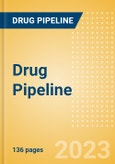Obesity is a complex multifactorial disease characterized by an excess of adipose tissue. It results from an intricate interplay between environmental, genetic, and psychosocial factors, which together arbitrate the balance between food intake and expenditure of energy. Obesity is a primary cause of many life-threatening diseases, including cardiovascular diseases, type 2 diabetes (T2D), chronic kidney disease (CKD), osteoarthritis, metabolic syndrome (MetS), and early mortality.
Growth in the obesity market is expected to be driven by the potential introduction of 13 promising late-stage pipeline products into the market during the forecast period.
This report covers the 7MM (US, France, Germany, Italy, Spain, UK, Japan) and provides an Excel-based forecast model for the obesity market through 2031.
Forecast includes the 7 major markets (7MM)
Forecast covers the period 2021-2031
Growth in the obesity market is expected to be driven by the potential introduction of 13 promising late-stage pipeline products into the market during the forecast period.
This report covers the 7MM (US, France, Germany, Italy, Spain, UK, Japan) and provides an Excel-based forecast model for the obesity market through 2031.
Forecast includes the 7 major markets (7MM)
Forecast covers the period 2021-2031
- Drug sales in the obesity pharmacotherapy market are expected to grow by a significant margin between 2021 and 2031, with an overall compound annual growth rate (CAGR) of 31.3% over the forecast period, reaching $37.1 billion by 2031.
- Growth in the obesity market will be driven by the launch of 13 new pipeline products, including Novo Nordisk's Wegovy (semaglutide), CagriSema (semaglutide + cagrilintide), and oral semaglutide (NN-9932), Eli Lilly's tirzepatide, retatrutide, and orforglipron, Versanis Bio's bimagrumab (BYM338), and Pfizer's PF-07081532 and danuglipron tromethamine.
Scope
- Overview of obesity, including epidemiology, symptoms, diagnosis, and disease management.
- Annualized diabetic neuropathic pain therapeutics market revenue, cost of therapy per patient, and treatment usage patterns forecast from 2021 to 2031.
- Key topics covered include strategic competitor assessment, market characterization, unmet needs, clinical trial mapping, and implications of these factors for the diabetic neuropathic pain therapeutics market.
- Pipeline analysis: comprehensive data assessing emerging trends and mechanisms of action under development for diabetic neuropathic pain treatment. The most promising candidates in Phase III and Phase IIb development are profiled.
- Analysis of the current and future market competition in the global diabetic neuropathic pain therapeutics market. Insightful review of the key industry drivers, restraints and challenges. Each trend is independently researched to provide qualitative analysis of its implications.
Reasons to Buy
- Develop and design your in-licensing and out-licensing strategies through a review of pipeline products and technologies, and by identifying the companies with the most robust pipeline.
- Develop business strategies by understanding the trends shaping and driving the 7MM obesity therapeutics market.
- Drive revenues by understanding the key trends, innovative products and technologies, market segments, and companies likely to impact the 7MM obesity therapeutics market in the future.
- Formulate effective sales and marketing strategies by understanding the competitive landscape and by analyzing the performance of various competitors.
- Identify emerging players with potentially strong product portfolios and create effective counter-strategies to gain a competitive advantage.
- Organize your sales and marketing efforts by identifying the market categories and segments that present maximum opportunities for consolidations, investments and strategic partnerships.
Table of Contents
1 Obesity: Executive Summary
2 Introduction
3 Disease Overview
4 Epidemiology
5 Disease Management
6 Competitive Assessment
7 Unmet Needs and Opportunity Assessment
8 R&D Strategies
9 Pipeline Assessment
10 Pipeline Valuation Analysis
11 Current and Future Players
12 Market Outlook
13 Appendix
List of Tables
List of Figures
Companies Mentioned (Partial List)
A selection of companies mentioned in this report includes, but is not limited to:
- Novo Nordisk
- Eli Lilly
- Pfizer
- Boehringer Ingelheim
- Zealand Pharma
- OPKO Health
- Versanis Bio Inc.
- Rhythm Pharmaceuticals
- Roche
- H2-Pharma
- Chelapharm
- Vivus Inc.
- Orexigen Therapeutics
- Currax Pharmaceuticals
- FUJIFILM Toyama Chemical Co Ltd








